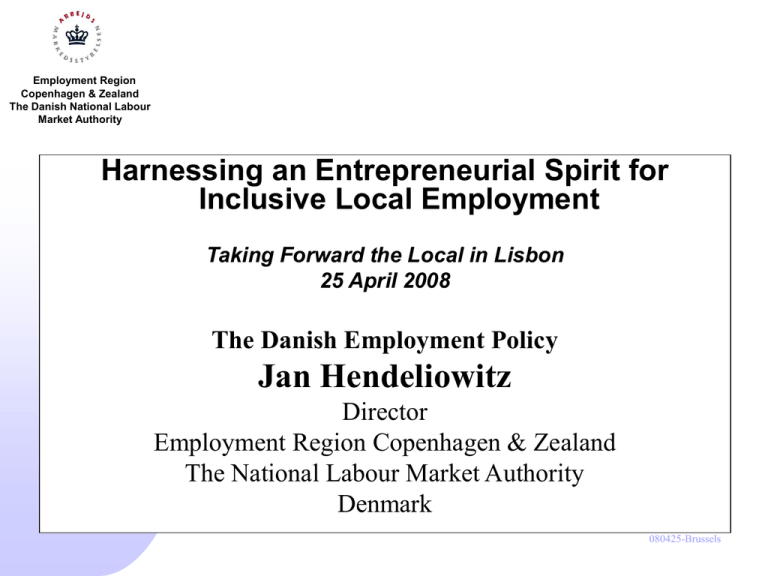PPT - The OECD LEED Forum on Partnerships and Local Governance
advertisement

Employment Region Copenhagen & Zealand The Danish National Labour Market Authority Harnessing an Entrepreneurial Spirit for Inclusive Local Employment Taking Forward the Local in Lisbon 25 April 2008 The Danish Employment Policy Jan Hendeliowitz Director Employment Region Copenhagen & Zealand The National Labour Market Authority Denmark 080425-Brussels Employment Region Copenhagen & Zealand The Danish National Labour Market Authority Facts about Denmark • Total population 5.4 million • Work force 2.9 million • Employed people 2.8 million • Employment rate 76.8 % • Unemployment rate 2.1 % • Youth unemployment 1.9 % source: www.jobindsats.dk (Statistics Denmark) 080425-Brussels Employment Region Copenhagen & Zealand The Danish National Labour Market Authority Employment Regions in Denmark North Jutland Employment Region 0.6 million Central Jutland Employment Region 1.2 million South Denmark Employment Region 1.2 million Copenhagen and Zealand Employment Region 2.4 million 080425-Brussels Employment Region Copenhagen & Zealand The Danish National Labour Market Authority Unemployment rates in Denmark, EU and OECD 1991-2007 12,0 10,0 Procent 8,0 6,0 4,0 2,0 19 91 19 92 19 93 19 94 19 95 19 96 19 97 19 98 19 99 20 00 20 01 20 02 20 03 20 04 20 05 20 06 20 07 0,0 Denmark EU OECD Source: OECD 080425-Brussels Youth unemployment Employment Region Copenhagen & Zealand The Danish National Labour Market Authority Unemployment rates in the 15-30 age range in Denmark, EU-15 and OECD, 1991-2006 20 Per cent 16 12 8 4 0 91 9 1 93 9 1 95 9 1 97 9 1 Denmark 99 9 1 EU-15 01 0 2 03 0 2 05 0 2 OECD Source: OECD 080425-Brussels Employment Region Copenhagen & Zealand The Danish National Labour Market Authority The Danish Flexicurity Model Limited degree of employment protection and high job mobility - 800,000 or circa 30 % of all Danish wage earners change their jobs each year - 20% of the work force experiences unemployment each year The main axis of the flexicurity model Flexible labour market The qualification effect of the LMP Generous welfare schemes Active LMP Motivational effects of LMP High compensation rates - 3000 USD a month before tax Activation is both a right and an obligation - In Denmark 1.7 % of GDP is spent on active measures and 2.5 % on passive measures 080425-Brussels Expenditure on labour market policy Employment Region Copenhagen & Zealand The Danish National Labour Market Authority Denmark Belgium Netherlands Germany Finland Sweden France Spain Norway Ireland Italy Luxembourg Australia Canada United Kingdom Japan Czech Republic United States Korea 0 1 2 3 4 5 Expenditure as share of GDP (%) Active measures Source: OECD – Employment outlook 2007 Passive measures 080425-Brussels Employment Region Copenhagen & Zealand The Danish National Labour Market Authority Perception of job security & satisfaction Job security Job satisfaction Scale from 1 to 10, from low to high job security Percentage of those employed who are satisfied or very satisfied with their jobs 10 100 8 80 6 60 4 40 2 20 0 0 Source: European Opinion Research Group EEIG (2001) Source: European Foundation for the Improvement of Living and Working Conditions (2006) 080425-Brussels Employment Region Copenhagen & Zealand The Danish National Labour Market Authority The main elements of the flexicurity model • A flexible labour market with low employment protection and high job mobility • A generous welfare system with high income security • An active labour market policy • Collective agreements between the parties in the labour market • Dynamic legislative process – regular review and revision 080425-Brussels Employment Region Copenhagen & Zealand The Danish National Labour Market Authority Regime Regime A Northern European regime Regime B Anglo-Saxon regime Characteristics of the labour market policies of the four regimes Policies • High compensation rates • Strict requirements concerning availability for work • Active LMPs • Low to average employment protection • Low compensation rates • Few formal requirements concerning availability for work • Varying degree of active LMPs • Limited employment protection Countries Denmark Netherlands Sweden Ireland United Kingdom Regime C Central European Regime • Varying compensation rates • Varying requirements concerning availability for work • Passive LMPs • Average to high employment protection Austria Belgium Finland Germany Regime D Southern European regime • Average compensation rates • Strict requirements concerning availability for work Passive LMPs • High employment protection France Italy Spain Portugal Greece Source: Medium Term Economic Outlook, Danish Ministry of Finance, 2004:12. 080425-Brussels Employment Region Copenhagen & Zealand The Danish National Labour Market Authority Employment/population ratios, labour force participation rates and unemployment rates 2006 Countries ordered by regime Employment/population ratio Labour force participation rate Unemployment rate Regime A: Denmark 76.9 80.1 4.0 Sweden 74.5 80.2 7.1 Netherlands 72.4 75.7 4.4 United Kingdom 72.5 76.7 5.4 United States 72.0 75.5 4.7 Ireland 68.1 71.3 4.4 Austria 72,2 75.9 5.0 Belgium 60,4 65.9 8.4 Finland 68.9 74.7 7.8 Germany 67.2 75.0 10.4 France 62.3 69.1 9.8 Italy 58.4 62.7 6.9 Spain 65.7 71.9 8.6 Portugal 67.9 73.9 8.1 Korea 63.8 66.2 3.6 OECD Europe 62.5 68.3 Total OECD 66.1 70.5 Regime B: Regime C: Regime D: Not categorised by regime 8.5 080425-Brussels 6.3 Employment Region Copenhagen & Zealand The Danish National Labour Market Authority Total hours worked annually per person of working age 2005 Source: OECD 2007 080425-Brussels Employment Region Copenhagen & Zealand The Danish National Labour Market Authority The political and institutional set-up of the Employment Service Minister for Employment National level The National Employment Council Sets the focus areas and objectives of the employment effort National Labour Market Authority Contract 4 Employment Regions Regional operational units Responsible for supervision of the labour market etc. Supervision of effects and outcomes etc., including follow-up of the Minister's objectives Regional level Approves the States part of the performance audit and the employment plan 4 regional employment councils Supervision and follow-up of the effects and outcomes of the job centres’ total employment effort 77 job centres 14 pilot job centres State service Local level Municipal service 91 local employment councils Municipal service The municipal councils approve the performance audit and the employment plan for their own job centres. In each job centre the state and the municipality share the responsibility for the employment effort. In the pilot job centres the municipal council alone approves the performance audit and the employment plan. 080425-Brussels Employment Region Copenhagen & Zealand The Danish National Labour Market Authority The planning and monitoring process in Job Centres Employment plan The final employment plan is sent to the Regional Employment Council Follow up and supervision Regular follow-up of the job centres performance by the employment regions Analysis of the labour market situation Analysis reports compiled by the Employment Regions and the Regional Employment Councils National targets The Minister announces the national targets and focus areas for next year October December Jan March Juli September April June Regional targets The targets are specified in a contract between the Minister, the Employment Regions and the Regional Employment Councils Local targets The job centres involve the Local Employment Councils in the process of setting the local targets for the coming year 080425-Brussels Employment Region Copenhagen & Zealand The Danish National Labour Market Authority The national performance targets for 2008 set by the Minister of Employment Performance target 1: • Decrease in the number of unemployed people over 3 months. Performance target 2: • Focus on people who have been unemployed for more than a year, as well as the targets set under the national initiative known as ”A New Chance For Everyone”. These targets are: 1) 25 per cent will enter employment or training 2) The target group will be self-supporting 15 per cent of the time 3) The target group will be participating in an activation scheme 40 per cent of the time. Performance target 3: • Decrease in the number of unemployed young people (i.e. those under 30) 080425-Brussels Employment Region Copenhagen & Zealand The Danish National Labour Market Authority Follow-up procedures • The Employment Regions closely follow up the performance outcomes being pursued in the job centres • Quarterly analysis reports are compiled by the Employment Regions on the basis of the overall national and regional targets • The reports contain an assessment of the effects and outcomes achieved by the respective Employment Regions, plus a benchmarking of the individual job centres • Dialogue meetings concerning outcomes are held with the Job Centres twice a year or more 080425-Brussels Employment Region Copenhagen & Zealand The Danish National Labour Market Authority Example of benchmarking of Job Centres The proportion of the target group of long-term unemployed on social welfare ”A New Chance for Everyone” that is self-supporting, 3rd quarter of 2007 45,0% 40,0% 35,0% 30,0% 25,0% 20,0% 15,0% 9,7% 10,0% 0,0% Rødovre København Hillerød Herlev Frederiksberg Lejre Høje-Taastrup Glostrup Køge Lolland Brøndby Bornholm Helsingør Ballerup Roskilde Holbæk Vallensbæk Fredensborg Odsherred Gladsaxe Gentofte Allerød Hvidovre LyngbyHalsnæs Tårnby Guldborgsund Albertslund Slagelse Greve Vordingborg Furesø Faxe Kalundborg Hørsholm Ringsted Solrød Gribskov Frederikssund Rudersdal Stevns Næstved Egedal Sorø Østdanmark 5,0% Source: Effects of employment efforts in the Eastern Denmark Employment Region, 3rd quarter of 2007 080425-Brussels Employment Region Copenhagen & Zealand The Danish National Labour Market Authority Example of benchmarking of Job Centres The development in the number of unemployed young people in the period September 2006 – September 2007 20,0% 10,0% 0,0% -10,0% -16,6% -20,0% -40,0% Stevns Vallensbæk Tårnby Odsherred Gribskov Hillerød Slagelse Næstved Vordingborg Rudersdal Høje-Taastrup Gladsaxe Lejre Bornholm Lolland Greve Kalundborg Herlev Helsingør Holbæk Faxe Fredensborg Brøndby Guldborgsund Ballerup Gentofte Furesø Frederikssund Ringsted København Allerød Roskilde Glostrup Rødovre Frederiksberg Hvidovre Køge Lyng.-Taarb. Albertslund Solrød Hørsholm Egedal Sorø Halsnæs Østdanmark -30,0% Source: Effects of employment efforts in the Eastern Denmark Employment Region, 3rd quarter of 2007 080425-Brussels Employment Region Copenhagen & Zealand The Danish National Labour Market Authority In summary: The Job Centres • Have a high degree of freedom in planning and implementing their employment initiatives and activities • Are obliged to focus on outcomes, and to achieve results which contribute to the realization of the national and regional outcome performance The Employment Regions • Are responsible for ensuring coherence between the local initiatives and the National Employment Policies • Follow up the performance outcomes of the employment measures being pursued in the job centres The Minister of Employment • Sets the national targets and focus areas 080425-Brussels








